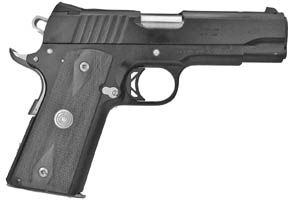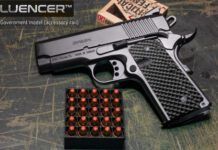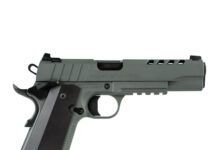
The Browning-designed 1911 pistol comes in many shapes and sizes, but for concealed carry, one of the more popular variations is the Commander size. The Commander 1911 pistol has a shorter barrel and slide than a 5-inch .45 ACP, but it maintains the same grip frame as the Government model and therefore the same capacity. Standard barrel length on the Commander is 4.25 inches, but it is not uncommon to refer to any 1911 with a barrel measuring 4 to 4.25 inches as being Commander-length.
In this test we will look at three such pistols: the Para Ordnance LTC, $749; Kimber’s Tactical Pro II, $1,060; and the Rock River Arms Commando Elite, $1,560. From the outside each pistol is similar. But differences in price and availability are remarkable. The Para Ordnance and Kimber pistols are available over the counter, but are priced hundreds of dollars apart. More expensive still, the Rock River pistol requires a waiting time of at least 6 to 8 months for delivery. Which one offers the best mix of performance, value, and availability? We went to the range to find out.
[PDFCAP(1)]
Rock River Arms, located in Colona, Illinois, is a manufacturer of custom rifles, pistols, parts, and accessories. Rock River has been forging pistol frames and slides for some time, but according to one factory representative, they began offering complete pistols about five years ago. Availability is direct from Rock River or from a Rock River stocking dealer. According to the manufacturer, the wait for a pistol from Rock River Arms is approximately six to nine months, unless you can locate a dealer that has one on his shelf. We called seven different dealers located in four different parts of the country from the list on RRA website,
The Rock River Commando Elite offered a list of features typical of custom pistols. Among them were a relieved hammer and an adjustable aluminum trigger; checkered wood grips; beveled magazine well; 30-lpi checkering on the front strap and mainspring housing; lowered and flared ejection port; cocking serrations fore and aft on the slide; beavertail grip safety with raised platform; and Novak sights with tritium inserts. The thumb safety was left side only, and a standard-length guide rod was used. The Commando Elite was built on a steel frame and featured a 4.25-inch Kart match barrel and bushing. The gun came with two eight-round magazines with flat followers.
We wanted to find out if the Commando Elite was worth the money and the wait. For testing accuracy, we chose [PDFCAP(2)] to represent the kinds of ammunition that shooters were most likely to use for practice and self-defense. For general range use we chose the Black Hills remanufactured 230-grain FMJ rounds. For defense our selection consisted of 200-grain hollow points from Hornady plus 185-grain and 230-grain JHP rounds from Black Hills Ammunition. The Hornady 200-grain JHP/XTP rounds produced the most muzzle energy, averaging nearly 400 ft.-lbs.
Average velocity for our test ammunition ranged from 775 fps from the 230-grain FMJ rounds to 940 fps firing the Hornady bullets. We had no malfunctions of any kind. The only casualty was a loss of finish to the forward surface of the slide due to holster wear.
Our Commando Elite was the most expensive pistol in this test, but it was also the most accurate. Our average group size for all shots fired measured just less than 2.0 inches, inflated by as much as 0.25 inch by our performance with the Hornady rounds. Our best single group from all three pistols in this test was the result of combining the Commando Elite with the Black Hills 230-grain FMJ round. Our “best of test” five-shot group measured 1.1 inches center to center at 25 yards.
[PDFCAP(3)]
Kimber was one of the manufacturers that have been responsible for the rebirth of the 1911 as a popular weapon. One reason for this might be that in the 1990s with the use of modern methods such as computer numerically controlled (CNC) machining and metal injection molding (MIM), Kimber was able to produce an appealing and reliable 1911 pistol for a reasonable price. Today, Kimber offers one of the largest selections of 1911-style pistols available.
Our Tactical Pro II was built on an alloy frame and offered the majority of features found on the more expensive Rock River pistol. This included night sights and checkering (30 lpi on the front strap, 20 lpi on the rear), plus a relieved hammer, aluminum trigger, and checkered wood grips. The Tactical Pro II pistol had rear cocking serrations only, and they were coarser than the Commando Elite’s. But the Kimber did offer ambidextrous thumb safeties, a magazine guide, Allen-head grip screws and a two-tone finish not found on the Rock River product. The underside of the trigger guard was also checkered, a feature only a few shooters will favor or perhaps even notice.
The Tactical Pro II utilized a full-length guide rod and bull-barrel design. To remove weight from the barrel, a section between the hood and the muzzle had been machined away. The likely intention here was to reduce the amount of energy necessary to lock and unlock the barrel, enhancing reliability and making the gun weigh less. At 29 ounces the Kimber was the lightest pistol in this test, and the difference in weight made the Tactical Pro II more appealing than the other two pistols as a carry gun.
Current Kimber design is distinguished by a firing-pin safety system that is controlled by compressing the grip safety, and external mounting of the extractor. Kimber says the external extractor is supposed to be more reliable, but detractors will say that it is just a money-saving shortcut that makes the slide weaker. Because we had no ejection-related malfunctions, we think the extractor design proved itself.
The grip safety on the Tactical Pro II was thicker toward the bottom, where it blended in with the mainspring housing. But it did not offer the raised platform that has become so popular. We would have liked this pistol better if it had incorporated a raised grip safety. This is because we found ourselves too conscious of the need to compress the grip safety. We think this affected our shooting. Furthermore, each of our staffers found that the web of the strong hand was pinched by the rear edge of the thumb-safety connecting plate.
The supplied panels on the Tactical Pro II were quite wide, and we found that slimmer grips only made the gun less comfortable. Shaving down the connecting platform on the left-side thumb safety may be the answer.
Nevertheless, we were able to complete our accuracy tests. The results showed average groups that varied little in size, ranging from 2.8 to 3.0 inches. We did experience one failure to feed, but that bobble may have been caused by our gun-support setup dragging on the slide. It was the only malfunction of the test.
[PDFCAP(4)]
Based in Scarborough, Ontario, Para Ordnance was one of the first manufacturers to offer high capacity in a 1911 production pistol. To get these capacities, Para used a wide body receiver that housed a double-column magazine, rather than stacking the ammunition in a single vertical column. Para Ordnance has not given up on their high-capacity design but with the popularity of the single-stack 1911 booming, Para now offers a lineup of three single-action pistols with the narrower traditional width. The model SSP is the 5-inch Government model, the OPS is a subcompact pistol, and the LTC uses a 4.25-inch barrel.
The LTC had the lowest MSRP of our test pistols, but it still offered checkered wood grips held by polished Allen screws, a 20-lpi checkered mainspring housing, relieved hammer, beavertail grip safety with raised platform, an aluminum trigger and a full-length guide rod. The magazine well was beveled, and the sights were a non-snag design with three white dots. Our LTC was built on a steel frame and weighed in at 36 ounces. An alloy-framed model will also be available, and according to the website,
The supplied sights were similar to the Novak system, but the rear sight was rounded at the top. In aligning the front sight for elevation at the peak of the rear notch, we questioned the effectiveness of this design. The rear face was lined to reduce glare. Two painted white dots in the rear sight cheapened the look of this pistol, we thought. In our view, the two dots didn’t really fit with the semicircle profile of the rear blade. A solid white line directly below the notch might have been a better choice.
The LTC was fitted with a passive safety designed to prevent movement of the firing pin until the trigger was intentionally pressed. Any effect this had on the feel of the trigger was barely noticeable. The Regal Para Kote proved to be durable, but it was a little too slick for our taste. In fact, after a small amount of oil had seeped onto the slide, we found out that the cocking serrations were useless. We had to first clean the slide before we could charge the pistol.
The gun’s extractor has been redesigned. The Para Power Extractor is aimed at enhancing reliability by increasing the contact area between the case and the extractor. The new PXT extractor is described as a “massive claw that gives you 50 percent more contact with the rim of a 45 case….” Indeed, this extractor was visibly much larger than those found on the Rock River Commando Elite and Kimber Tactical Pro II. Although we would not necessarily describe our method of evaluation as a “torture test,” we did get this gun very dirty thanks to a variety of ammunition, including hand loads topped with lead and moly-coated bullets. Happily, we encountered no problems of any kind throughout our test of the Para Ordnance LTC.
From the 25-yard line we printed average groups ranging from 2.4 to 2.8 inches, edging out the more expensive Kimber Tactical Pro II. Our best single group with the LTC measured only 1.5 inches from center to center, firing the 185-grain JHP rounds from Black Hills. If we hadn’t dropped a 3.2-inch group, the resulting average would have been much better.
Gun Tests Recommends
• Rock River Commando Elite, $1,560. Conditional Buy. We think this is a better-than-average pistol priced below comparable products from individual custom gunsmiths. But the waiting period is a big drawback for most people.
• Kimber Tactical Pro II $1,080. Conditional Buy. Depending on the shooter, this gun may have to be modified to make it comfortable, but it was a steady performer light enough for daily carry.
• Para Ordnance LTC, $749. Best Buy. You can’t argue with this gun’s looks, performance, or pricing.




























